New Trailer for iPad Exclusive Mailmen
![]() Anti-gravity platformer games are really un-explored territory when it comes to iOS games. Actually, I can’t really think of one title that has taken complete advantage of gravity mechanics. Until now. Inertia: Escape Velocity, developed by Red Fly Studio, could very well be the first iOS platformer game to seriously manipulate gravity, using the mechanics as the core of the game, and they pull it off perfectly. I guess it should be brought up that Red Fly Studio has built Inertia: Escape Velocity expanding on award-winning gameplay that won Best Non-Professional Game, Achievement in Gameplay, Technical Achievement, and Gamers’ Choice Awards at DICE’s Indie Game Challenge this year (2011).
Anti-gravity platformer games are really un-explored territory when it comes to iOS games. Actually, I can’t really think of one title that has taken complete advantage of gravity mechanics. Until now. Inertia: Escape Velocity, developed by Red Fly Studio, could very well be the first iOS platformer game to seriously manipulate gravity, using the mechanics as the core of the game, and they pull it off perfectly. I guess it should be brought up that Red Fly Studio has built Inertia: Escape Velocity expanding on award-winning gameplay that won Best Non-Professional Game, Achievement in Gameplay, Technical Achievement, and Gamers’ Choice Awards at DICE’s Indie Game Challenge this year (2011).
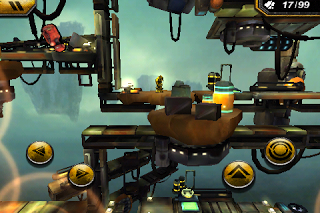 You’ll guide a robot who has crash landed on a distant planet through 35 levels, collecting items that you can use to put your ship back together. The fun part? You can manipulate gravity, and use a ton of interesting objects to get you through hazards and around difficult corners of the levels.
You’ll guide a robot who has crash landed on a distant planet through 35 levels, collecting items that you can use to put your ship back together. The fun part? You can manipulate gravity, and use a ton of interesting objects to get you through hazards and around difficult corners of the levels. 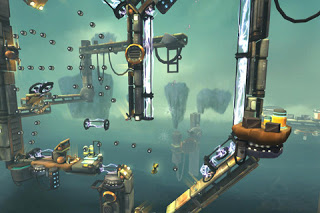 Inertia: Escape Velocity is, to say the least, a huge game. The 35 levels all have 3 badges for you to earn, one for completion, one for picking up all of the bolts in the level, and another for finishing the level in a certain amount of time. Getting each one of these will require multiple playthroughs. Once you beat all 35 of the original stages, if you want more, you can purchase another 24 levels, each called the Inferno levels, which are the original levels, but set up like challenge levels, with increased difficulty, and different objects to use, more hazards, and a certain amount of big red bolts to collect so that you can open up the Mastery Levels, which are 5 of the hardest levels in the game, each also having the 3 badges to try and snag, all for $0.99. The original game is $1.99, so for all of the levels it’ll be $2.99. But if you decide not to buy the extra levels, the original 35+ levels will give you quite a bit of gameplay, taking about 4 hours to complete, not counting all the hours you can sink into them going back trying to grab all of the items and beating the level times. For the price, Inertia: Escape Velocity is an amazing game, and a definite must buy. It’s very quickly moved up to the #4 spot on my top 5 games of the year, making it incredibly easy to recommend to any and all platform and puzzle lovers.
Inertia: Escape Velocity is, to say the least, a huge game. The 35 levels all have 3 badges for you to earn, one for completion, one for picking up all of the bolts in the level, and another for finishing the level in a certain amount of time. Getting each one of these will require multiple playthroughs. Once you beat all 35 of the original stages, if you want more, you can purchase another 24 levels, each called the Inferno levels, which are the original levels, but set up like challenge levels, with increased difficulty, and different objects to use, more hazards, and a certain amount of big red bolts to collect so that you can open up the Mastery Levels, which are 5 of the hardest levels in the game, each also having the 3 badges to try and snag, all for $0.99. The original game is $1.99, so for all of the levels it’ll be $2.99. But if you decide not to buy the extra levels, the original 35+ levels will give you quite a bit of gameplay, taking about 4 hours to complete, not counting all the hours you can sink into them going back trying to grab all of the items and beating the level times. For the price, Inertia: Escape Velocity is an amazing game, and a definite must buy. It’s very quickly moved up to the #4 spot on my top 5 games of the year, making it incredibly easy to recommend to any and all platform and puzzle lovers. 
![]() Full on destruction games are kind of a niche genre within the AppStore, there’s really only a couple of titles that I can think of using destruction as a core mechanic, Destructopus, Robot Rampage, and to a lesser extent, Blast Zone Mega, and Burn The City, which is really more in the line of an Angry Birds type physics puzzler, but you get the idea. It’s not a genre that’s been well expanded on. Andrew Wang, and Ayopa Games (W.E.L.D.E.R., Chicken Rescue) are giving us one more title to add to that very short list. Inspired by the classic arcade game, Rampage, and taking influences from The Simpsons and Futurama, as well as trying to incorporate the customization of Mechwarrior, BigBot Smash is now available for our iDevices, and fingertips that are hungry for destruction.
Full on destruction games are kind of a niche genre within the AppStore, there’s really only a couple of titles that I can think of using destruction as a core mechanic, Destructopus, Robot Rampage, and to a lesser extent, Blast Zone Mega, and Burn The City, which is really more in the line of an Angry Birds type physics puzzler, but you get the idea. It’s not a genre that’s been well expanded on. Andrew Wang, and Ayopa Games (W.E.L.D.E.R., Chicken Rescue) are giving us one more title to add to that very short list. Inspired by the classic arcade game, Rampage, and taking influences from The Simpsons and Futurama, as well as trying to incorporate the customization of Mechwarrior, BigBot Smash is now available for our iDevices, and fingertips that are hungry for destruction.
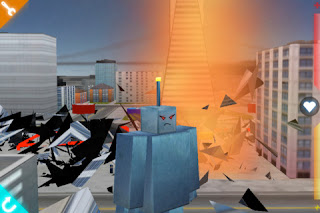 To start it off, the controls in BigBot Smash will take quite a bit of getting use to, but once you do, even more problems show their face. There are two different control schemes included in the game. The first control method uses the iDevice’s accelerometer, tilting to turn the world that you’ll be destroying. This can be extremely difficult to use, as you’ll need to turn your device completely around to turn your robot around, and tilt it in pretty uncomfortable ways to turn. Tapping on the screen controls your robots projectiles, and tapping on the robot will make it jump. If you tap on a building that is close to the robot, it will smash it with it’s fists. Here’s where it gets even more difficult. If the building is just a little bit too far away, you’ll shoot at it instead of smashing it, which takes up quite a bit of time, which can be pretty frustrating in the Speedrun Mode, but outside of the Speedrun Mode, it’s just bothersome. Tapping on your robot also does not always make it jump, sometimes it will jump, and other times it will destroy the building right in front of it. There are touch controls as well, which have the same sort of issues as the tilt controls, except you won’t be tilting your device in uncomfortable ways, instead, you’ll be dragging your finger on the screen to change the robot’s direction. However, this also has it’s own issues, as more than half of the time, dragging your finger across the screen is registered as a tap, and will result in the robot shooting it’s projectiles. It’s not so bad that you won’t be able to play the game, but once you hit stage 4 in the campaign mode, and the game gets a little more hectic, you’ll be constantly wanting to turn the game off out of frustration. The same goes for the speed demolition and survival challenge modes, once the game reaches that point where the action picks up, the controls become a real issue.
To start it off, the controls in BigBot Smash will take quite a bit of getting use to, but once you do, even more problems show their face. There are two different control schemes included in the game. The first control method uses the iDevice’s accelerometer, tilting to turn the world that you’ll be destroying. This can be extremely difficult to use, as you’ll need to turn your device completely around to turn your robot around, and tilt it in pretty uncomfortable ways to turn. Tapping on the screen controls your robots projectiles, and tapping on the robot will make it jump. If you tap on a building that is close to the robot, it will smash it with it’s fists. Here’s where it gets even more difficult. If the building is just a little bit too far away, you’ll shoot at it instead of smashing it, which takes up quite a bit of time, which can be pretty frustrating in the Speedrun Mode, but outside of the Speedrun Mode, it’s just bothersome. Tapping on your robot also does not always make it jump, sometimes it will jump, and other times it will destroy the building right in front of it. There are touch controls as well, which have the same sort of issues as the tilt controls, except you won’t be tilting your device in uncomfortable ways, instead, you’ll be dragging your finger on the screen to change the robot’s direction. However, this also has it’s own issues, as more than half of the time, dragging your finger across the screen is registered as a tap, and will result in the robot shooting it’s projectiles. It’s not so bad that you won’t be able to play the game, but once you hit stage 4 in the campaign mode, and the game gets a little more hectic, you’ll be constantly wanting to turn the game off out of frustration. The same goes for the speed demolition and survival challenge modes, once the game reaches that point where the action picks up, the controls become a real issue. 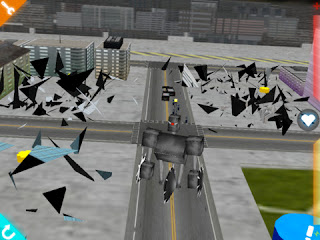 For $0.99, it’s not a bad game by any means. The controls can be worked with, and might actually just have so many issues if you’re playing on a small screen. Gameplay videos on the iPad show the game in a completely different light, and since the game is Universal, you won’t need to buy an HD version to find out. There are GameCenter leader boards, though only for Survival and Speed modes, but do have 48 achievements to try and grab. There is quite a bit of replay value, and the core gameplay looks like it could be great fun. But until an update hits with some tighter controls, it’s hard to really give the game a fair play on my small screen, but I’m excited about having the opportunity to.
For $0.99, it’s not a bad game by any means. The controls can be worked with, and might actually just have so many issues if you’re playing on a small screen. Gameplay videos on the iPad show the game in a completely different light, and since the game is Universal, you won’t need to buy an HD version to find out. There are GameCenter leader boards, though only for Survival and Speed modes, but do have 48 achievements to try and grab. There is quite a bit of replay value, and the core gameplay looks like it could be great fun. But until an update hits with some tighter controls, it’s hard to really give the game a fair play on my small screen, but I’m excited about having the opportunity to.
Recently I managed to get in touch with Rion Holland over at Lab Rats Studio, the development team behind upcoming Third-Person Shooter M.U.S.E. This game is shaping up to be a down-right awesome shooter and brings back memories of arcade-style multiplier mayhem. Look for preview screens after the break.
Lab Rats Studio was formed a little over a year ago by four Wake Technical Community College students with a passion for game development. We all knew finding jobs at game studios in today’s economy would be very difficult with no experience, so we decided to do it ourselves. Lab Rats Studio was one of the inaugural companies to complete Joystick Labs’ three month game development business accelerator program in Durham, North Carolina. We all had a drive to work on our own game and have creative control over the process, which is what led us to create Lab Rats Studio. We realized that the mobile market was growing and there was not a lot of heavy competition for a game like M.U.S.E. yet.
As a lot of other games do, we of course drew inspiration from other games that we enjoy. We knew we wanted to create a third person shooter that was visually impressive and consisted of “console-like” shooter gameplay. We sometimes describe M.U.S.E. as a sort of Sci-Fi Max Payne set in a dark alternate present day. Others have noted inspirations from games like Duke Nukem and Gears of War. We then added on top of the shooting a layer of arcade scoring and combo systems that gives the game a competitive aspect to compete with friends to get high scores where players can post high scores to leaderboards via GameCenter or OpenFeint. We, of course, feel like M.U.S.E. is totally different than any other game out there, especially on the mobile market.
Our biggest struggle has been that this is our first marketable game as a new game studio, so it has been a learning experience for all of us. We didn’t have a lot of time to spend in pre-production, which is a crucial stage of the game development process, that made us come up with concepts and designs within the production cycle. We also had a pretty large vision for what we wanted M.U.S.E. to be which had to be managed to make it work for mobile devices. As an independent game development studio, we struggled a lot with money and keeping a staff of up to nearly 10 people. All of the people on our development team are extremely talented and dedicated individuals that have continued to work their butts off for the past year to make this game happen. We have managed to create this game on a shoestring budget and are very proud of what we have accomplished.
We are bringing fun and immersive gameplay to the shooter genre on mobile devices. We took a play style that is popular on consoles and made it work for mobile devices so that people looking for a slightly more traditional “shooter” gameplay experience will feel at home in M.U.S.E. The controls have been through much testing and iteration to bring an intuitive and comfortable feeling as similar to a controller layout as possible. As briefly mentioned before, we added an arcade style scoring system and RPG inspired upgrade system to give the game some competition and replayability. Players will also be able to purchase currency via IAP for faster upgrades, or can play through the game and gain currency upon beating levels based off their scores. We are also very happy with the level of detail and quality of artwork we were able to accomplish on mobile devices that will only continue to get better as both we and the hardware continue to develop in the future.
M.U.S.E. will feature:
“Adrenaline Mode” is a feature we have added to M.U.S.E. that is similar to a “rage” mode in other games where Sid literally shoots himself in the leg with a shot of adrenaline and goes into a state of heightened awareness and power. First off, adrenaline is gained by dispatching enemies or destroying environment objects in game. When your adrenaline meter is full and begins to flash, you can enter adrenaline mode which will slowly regenerate the player’s health, puts an outline on enemies and destructible objects to make them easier to see, bursts the player into slow motion after kills and destruction so they can plan their next move, and puts a bloom effect on screen. While in adrenaline mode, you can extend the timer by continuing to kill enemies and destroy objects, and the longer you do so, the more your adrenaline multiplier increases (the 0.0x in the top right). Every kill in adrenaline mode is multiplied by this value, so kills 60 seconds into adrenaline mode will yield 6x the normal score value, and then multiplied again by whatever your current chain value is.
To put it simply, each enemy and destructible has a base score value that is multiplied by the value of the combo chain, and then again by the adrenaline multiplier if you’re in it. So if you kill a Vorg Zed Ultra (base score 700) with a 3x combo chain when the adrenaline multiplier is at 2.5x, you’ll net 5250 points. Adrenaline mode is both an emergency lifeline for those that are about to die and need that extra boost, and a high-scoring method for the elite player that is trying to top their friends’ high scores.
M.U.S.E. is planned for release in December 2011 just in time for the Holidays. We plan to price the game within the same realm of our competition.
We plan to put out a content update for M.U.S.E.: Episode 1 about a month after launch that will include two more levels and a final boss fight level to complete the episode. There will be some added enemy variations and possible new upgrades and weapons to use. After that, we plan to continue the game through three episodic installments to complete the franchise. We are striving to be a premiere cutting edge game development studio on the mobile market.
Tweet Worms. They are absolutely repulsive creatures used only to gross out people and to be placed in your parents spaghetti. But they seem to be used often as cute protagonists so I guess they have something going for them.
Worms. They are absolutely repulsive creatures used only to gross out people and to be placed in your parents spaghetti. But they seem to be used often as cute protagonists so I guess they have something going for them. 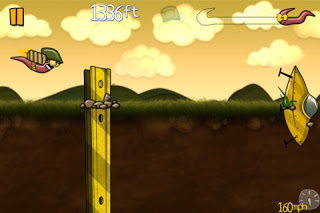 In this new worm filled adventure you star as a worm with a rocket on its back. Unfortunately at the party you are sleeping at, three jokesters light the rocket on your back causing you to be brutally propelled out of the window and into the world. It is your job as the player to take control of the worms path and make sure he doesn’t hit any obstacles on his flight. This is accomplished by taping the upper or lower part of the screen. By tapping the bottom of the screen you dive into the ground and by tapping the upper part you jump to avoid obstacles. Obstacles are placed in various different locations, requiring you to think fast to avoid making the wrong move. Some are embedded halfway in the ground allowing you to either jump or dive to avoid them while others take up all of the above ground area. Unfortunately after you have played through a few games all of the obstacles become fairly easy to avoid and not even your ever-increasing high speed makes these any more deadly. Also no new obstacles are introduced later in your never ending run so you can get bored of them easily. Also scattered among the level are power-ups which can do one of three things. Either give your worm another life, a helmet, or let him destroy anything in his path. You lose life’s by running into obstacles so its always a good idea to pickup a health or a helmet pick-up.
In this new worm filled adventure you star as a worm with a rocket on its back. Unfortunately at the party you are sleeping at, three jokesters light the rocket on your back causing you to be brutally propelled out of the window and into the world. It is your job as the player to take control of the worms path and make sure he doesn’t hit any obstacles on his flight. This is accomplished by taping the upper or lower part of the screen. By tapping the bottom of the screen you dive into the ground and by tapping the upper part you jump to avoid obstacles. Obstacles are placed in various different locations, requiring you to think fast to avoid making the wrong move. Some are embedded halfway in the ground allowing you to either jump or dive to avoid them while others take up all of the above ground area. Unfortunately after you have played through a few games all of the obstacles become fairly easy to avoid and not even your ever-increasing high speed makes these any more deadly. Also no new obstacles are introduced later in your never ending run so you can get bored of them easily. Also scattered among the level are power-ups which can do one of three things. Either give your worm another life, a helmet, or let him destroy anything in his path. You lose life’s by running into obstacles so its always a good idea to pickup a health or a helmet pick-up.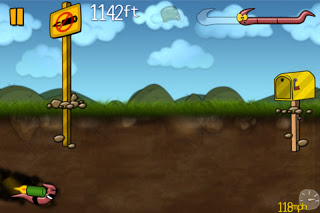 By completing certain pre-determined missions you can unlock new rocket types which don’t really do much other than look cool. If thats incentive enough for you to play hours and hours of this game then you really need to find something better to do with your time. Another annoying feature of this game is its achievment system. They choose to use something called Kiip points. Apparently you can redeem these Kiip points for real world items from certain companies. This system miserably fails for this game as you can only use them for Kodak pictures and is a big nuisance when playing the game.
By completing certain pre-determined missions you can unlock new rocket types which don’t really do much other than look cool. If thats incentive enough for you to play hours and hours of this game then you really need to find something better to do with your time. Another annoying feature of this game is its achievment system. They choose to use something called Kiip points. Apparently you can redeem these Kiip points for real world items from certain companies. This system miserably fails for this game as you can only use them for Kodak pictures and is a big nuisance when playing the game.
Overall this is a sub par endless runner which feels like a rip off of Tiny Wings and the original Worms franchise. I give it a 1/5.

![]() Shoot-em-ups have expanded quite a bit since Cave hit the iOS scene in April of 2010. However, very few games have done what Cave’s releases have done for the scene, so it’s nice to see a developer realize this, and take the genre in completely different direction. DarkWave Game’s new title, Act of Fury: Kraine’s Revenge, is a different kind of shmup for fans of the genre. A game in which, instead of shooting your enemies down, you get as close to them as you can, disabling their systems, and taking them down with a tornado like force that surrounds you.
Shoot-em-ups have expanded quite a bit since Cave hit the iOS scene in April of 2010. However, very few games have done what Cave’s releases have done for the scene, so it’s nice to see a developer realize this, and take the genre in completely different direction. DarkWave Game’s new title, Act of Fury: Kraine’s Revenge, is a different kind of shmup for fans of the genre. A game in which, instead of shooting your enemies down, you get as close to them as you can, disabling their systems, and taking them down with a tornado like force that surrounds you.
 To start things off, the graphics in Act of Fury are great. I have run into some slight jumping around of the screen when the levels start to scroll left or right, or zoom in and out, like when an air-strike comes in, however it’s nothing game-breaking, but is noticeable, and should be brought up. Aside from this, the variety with enemies is nice, the 4 different environments look great, and the animations are fantastic. The music and sounds go along nicely in passing on the feel of the world in Act of Fury as well.
To start things off, the graphics in Act of Fury are great. I have run into some slight jumping around of the screen when the levels start to scroll left or right, or zoom in and out, like when an air-strike comes in, however it’s nothing game-breaking, but is noticeable, and should be brought up. Aside from this, the variety with enemies is nice, the 4 different environments look great, and the animations are fantastic. The music and sounds go along nicely in passing on the feel of the world in Act of Fury as well. Act of Fury is a very interesting addition to the shmup genre. It does a fantastic job of mixing the Spirit/Bit Pilot/Silverfish type mechanics with shmup influenced gameplay, and presenting it all in an extremely polished and well rounded package. There are GameCenter and OpenFeint leader boards for each of the 9 stages in both Normal and Hell Modes, as well as a total score leader board for both Modes, along with 32 achievements, all adding immensely to the replay value, which, once you get into the Hell Mode levels, is already fairly high. With the price being $2, it’s definitely a game that’s worth every penny, and then some, especially if you’re a fan of the shoot-em-up genre. Act of Fury also runs on 2nd GEN devices, which, with this genre, is fantastic news.
Act of Fury is a very interesting addition to the shmup genre. It does a fantastic job of mixing the Spirit/Bit Pilot/Silverfish type mechanics with shmup influenced gameplay, and presenting it all in an extremely polished and well rounded package. There are GameCenter and OpenFeint leader boards for each of the 9 stages in both Normal and Hell Modes, as well as a total score leader board for both Modes, along with 32 achievements, all adding immensely to the replay value, which, once you get into the Hell Mode levels, is already fairly high. With the price being $2, it’s definitely a game that’s worth every penny, and then some, especially if you’re a fan of the shoot-em-up genre. Act of Fury also runs on 2nd GEN devices, which, with this genre, is fantastic news.